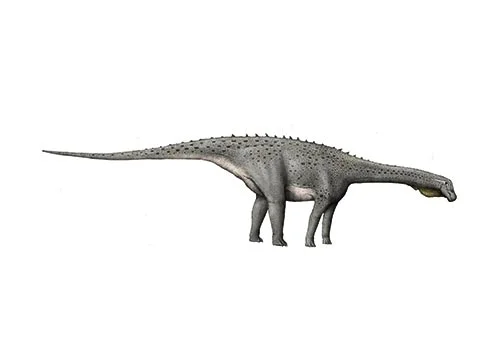Magyarosaurus (Magyar lizard)

Mag-yar-oh-sore-us
Friedrich von Huene - 1932
Herbivore
Estimated 6-7 meters long
Sauropod
M. dacus (type), M. hungaricus
Hungary- Transylvanian Basin, also Europe & Romania
Late Cretaceous, 75-70 million years ago
Magyarosaurus Facts
Magyarosaurus is a genus of dinosaur that lived during the Late Cretaceous period, approximately 70-75 million years ago. Its name, Magyarosaurus, means “Magyar lizard” in reference to the fact that its fossils were discovered in Hungary, in the area of the Transylvanian Basin.
Magyarosaurus was a relatively small sauropod dinosaur, with estimates placing its length at around 6-7 meters (20-23 feet) and its weight at around 1-2 tons. It had a long neck and tail, and four sturdy legs that supported its massive body. Like other sauropods, it was a herbivore, and its diet likely consisted of a variety of plants such as ferns, conifers, and cycads.
Despite its small size, Magyarosaurus was still an impressive dinosaur, and its fossils provide valuable insights into the evolution and biology of sauropod dinosaurs. It is known from a number of fossil specimens, including several partial skeletons, and many of these have been well-preserved, providing detailed information about the dinosaur’s anatomy.
One interesting aspect of Magyarosaurus is that it appears to have had a different number of vertebrae in its neck compared to other sauropods. While most sauropods had between 12 and 19 neck vertebrae, Magyarosaurus had only 10 or 11, which suggests that it may have had a shorter neck than its relatives.
Magyarosaurus is also notable for the fact that it was a dwarf dinosaur, meaning that it was much smaller than other members of its family. It is thought that this dwarfism was due to the limited resources available on the island where it lived, which would have made it difficult for larger dinosaurs to survive. This island, known as Haţeg Island, was a landmass that was separated from the rest of Europe during the Late Cretaceous, and it was home to a unique ecosystem of dinosaurs, including other dwarf sauropods, as well as predatory dinosaurs and small herbivorous dinosaurs.
Overall, Magyarosaurus is an important dinosaur because it provides a unique window into the world of Late Cretaceous dinosaurs in Europe, and it shows how these animals were able to adapt to changing environments and survive in isolated habitats. Its fossils continue to be studied by paleontologists around the world, and they are helping to shed light on the evolutionary history of dinosaurs and their many fascinating adaptations.



